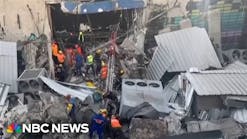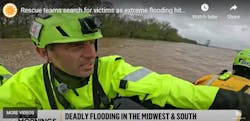INTRODUCTION
Public Safety and Rescue personnel should be appropriately trained and equipped in order to appropriately respond to an emergency on the ice or in the water. The level of training required, as well as the type of rescue equipment needed, should be based on the local community needs as determined through an assessment of the community and the development of pre-plans to appropriately respond to incidents.
THREAT ANALYSIS AND PRE-INCIDENT MANAGEMENT PLANNING
The term, Target Hazard, is a common term used within the Fire and Rescue sector to denote a structure or occupancy that has been determined to have a greater than average life hazard, or a structure that presents a greater degree of complexity for structural firefighting and/or EMS operations. Designated Target Hazards receive a high priority in the pre-incident management process and often a higher level of first-alarm response assignment. The designation of a structure or occupancy as a Target Hazard should be determined after a thorough inspection of the structure. It is then the duty and responsibility of the Fire and Rescue agency/department to pre-plan the emergency response and firefighting tactics and strategies that can be anticipated to occur at this particular structure or occupancy.
This concept of identifying Target Hazards, and the development of pre-plans to manage the incident should be expanded to include not only physical structures and occupancies, but also bodies of water (i.e. lakes, rivers, streams, ponds, etc.) within a community which can pose a danger to the public when engaged in recreational activities in, on and around the water or ice. The process of identifying physical hazards as well as activities that place persons at risk is referred to as a Threat Analysis.
As a normal part of any community's comprehensive risk management program, in order to eliminate or minimize the danger to the public, physical hazards must be identified and activities that place persons at risk must be assessed. The combination of a physical hazard and risk constitutes danger. When physical hazards are identified, they must be removed or corrected, or appropriate signage must be posted to adequately warn the public of the hazard. When activities that place persons at risk are assessed, these activities must be either prohibited, or appropriate safeguards must be implemented to protect the public while they are engaged in these activities.
However, within the natural environment, there are many attractions that do not come under the management responsibilities of any particular agency or individual. Therefore, local Public Safety and Rescue agencies should perform a comprehensive threat analysis within their community in order to determine potential incident sites and to develop appropriate pre-plans for those sites.
OPERATIONS
Once a threat analysis has been conducted within the community, and the potential for water or ice rescue incidents is identified, it is then the responsibility of the Fire and Rescue department to
(B) develop Standard Operating Procedures (SOPs) or Guidelines (SOGs) to appropriately and effectively implement these plans;
(C) train their personnel to respond appropriately; and
(D) provide their personnel with appropriate personal protective equipment and rescue equipment to effectively respond to these potential incidents.
Some large Public Safety and Rescue Agencies have the capability, due to their personnel and equipment resources, to develop technical or specialized rescue teams. In such cases, the formation, training, and equipping of an Ice Rescue Team can be easily accomplished. However, smaller departments do not have the equipment or personnel resources to train and select a specialized team. Therefore, generalized awareness training must be provided for all personnel and Technician level training provided for as many personnel as possible.
Regardless of the size of the department, Ice Rescue and Water Rescue Awareness training should be provided to all personnel which would include:
- Procedures for implementing the assessment phase of the ice or water incident;
- Procedures for size-up of existing and potential conditions;
- Procedures for identifying the resources necessary to conduct safe and effective ice and/or water rescue operations;
- Procedures for implementing the emergency response system for ice or water rescue incidents;
- Procedures for implementing site control and scene management;
- Procedures for recognition of general hazards associated with ice or water incidents, and the procedures necessary to mitigate these hazards within the general rescue area;
- Procedures to determine rescue vs. body recovery.
Fire and Rescue personnel trained at the Awareness Level should also be trained in procedures to identify the approximate location of a victim once the victim has submerged below the surface, and they should be capable of manning tether lines for operations/technician level personnel who venture out onto the ice or into the water for rescue or recovery purposes. Awareness level personnel can also be trained and equipped to perform basic shore-based rescues like throwing a line or rescue bag to the victim, or extending an object or device from shore. However, to function in this capacity, fire and rescue personnel must be equipped with basic rescue and personal protective equipment and must be trained in its proper use.
At the Ice Rescue Technician Level, personnel would have the responsibility of organizing and implementing the type of rescue necessary depending upon the physical and emotional condition of the victim, the equipment resources available, the location of the victim, and the personnel resources available. Technician level functions at ice and/or water rescue incidents must include the development and implementation of:
- Procedures for self-rescue unique to ice and cold water incidents;
- Procedures for reach, throw, row and go technique rescues unique to ice and cold water incidents;
- Procedures for the use of watercraft, specialty craft, and specialty equipment unique to ice and cold water rescue.
Again, in order to accomplish this level of rescue, Technician level personnel must be adequately equipped to protect themselves from the elements and to effectively and safely perform the rescue and/or recovery operation.





